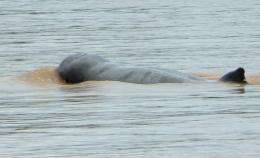WWF calls for action to save Mekong dolphins

Conservation group WWF on Wednesday called for urgent action to prevent the extinction of freshwater dolphins in the Mekong River, including the creation of special conservation zones.
Entanglement in fishing nets, low calf survival rates and a steady degradation of the creature's habitat are threatening the estimated 85 Irrawaddy dolphins left in Cambodia and Laos, WWF said.
"Evidence is strong that very few young animals survive to adulthood, as older dolphins die off and are not replaced," Li Lifeng, director of WWF's freshwater programme, said in a statement.
"This tiny population is at high risk by its small size alone. With the added pressures of gill net entanglement and high calf mortality we are really worried for the future of dolphins."
The group urged the Cambodian government to consider a ban on gill nets.
But the Cambodian official tasked with caring for the country's Irrawaddy dolphins criticised the group's research methods and insisted there remained "about 155 to 175" of the animals in the Mekong.
"WWF does not do proper scientific research. I do not know what kind of methodology they are using," Touch Seang Tana, chairman of Cambodia's Commission to Conserve Mekong River Dolphins and Develop Eco-tourism, told AFP.
He added that according to his findings, dolphin numbers were slowly improving. "Last year, we had 12 newborns," he said.
The government and WWF clashed over the same issue in 2009, when WWF estimated there were just 64 to 76 Irrawaddy dolphins left in the river, partly because of pollution and illegal fishing methods.
The group said its current estimate of 85 dolphins was higher because of better monitoring techniques, not because the population had increased.
It also said more research was needed to explain the calf deaths.
"We're still unsure, however it may be related to environmental factors such as contamination, or physiological issues in the small population. There is no evidence that low calf survival is due to fishing," Li told AFP.
The Mekong River Irrawaddy dolphin, which inhabits a 190-kilometre (118-mile) stretch in Cambodia and Laos, has been listed as critically endangered since 2004, the WWF said.
Irrawaddy dolphins are also found in coastal areas in south and southeast Asia, in the Irrawaddy river in Myanmar and in the Mahakam river in Indonesia, it added.
In recent years, the Cambodian government has been promoting dolphin-watching to attract eco-tourism and has cracked down on the use of illegal nets.
(c) 2011 AFP















